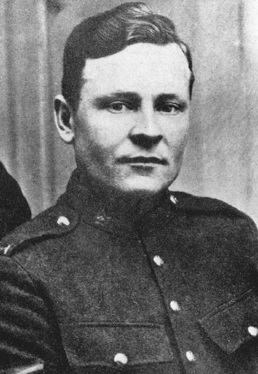In Library and Archives Canada’s Victoria Cross blog series, we profile Canada’s Victoria Cross recipients on the 100th anniversary of the day that they performed valiant actions for which they were awarded the Victoria Cross. Today we commemorate Sergeant Robert Spall, whose valiant actions and self-sacrifice on August 12 and 13, 1918 earned him the Victoria Cross.

Sergeant Robert Spall, VC, undated. Source: Wikimedia
Born in Ealing, Essex, England on March 5, 1890, Spall immigrated to Canada with his parents and settled in Winnipeg, Manitoba. He was a customs broker before the war and was a member of the Active Militia. On July 28, 1915, Spall enlisted in Winnipeg, joining the 90th Battalion of the Canadian Expeditionary Force (CEF). He arrived in France with the Winnipeg Rifles on February 13, 1916 at age 26. Later, the 90th Battalion would be absorbed by the 11th Reserve Battalion to provide reinforcements to the Canadian Corps. Eventually, Spall ended up in the Princess Patricia’s Canadian Light Infantry (PPCLI).
On August 12, 1918, German shells rained down on the PPCLI, the 116th Canadian Battalion, and the 42nd Canadian Battalion, keeping them in their respective trenches. Their objective was handed down at noon; in conjunction with the 42nd Battalion, PPCLI was to push the Germans out of Parvillers from the south. The plan was to move up to posts south of Parvillers held by the 9th Canadian Infantry and use them as jumping off points, while simultaneously bombing the trenches of the old German front line system and the trenches leading into Parvillers.
However, when the Company arrived at their assigned positions, it was discovered that the 9th Infantry did not control those points, and were still in the hands of the Germans. Despite the setback, the attack was to be carried out. At 8:00 p.m., the Canadians were met with heavy resistance, with little progress being made. Casualties were heavy on the German side as the Company pushed forward, with a bombing section moving down the German trench.

War diary from the PPCLI describing the attack when Spall fired at incoming German soldiers, August 1918, page 18, (MIKAN 2005881)
At 6:00 a.m. on August 13, 1918, the Germans counter-attacked heavily from Parvillers and Damery, coming out of the woods in a tight formation and attacking across the open. This sudden and vigorous attack forced the Company to retreat and head for the old German front line. In the mayhem, two platoons were cut off from the Company.
It is likely that Spall participated in this attack, and was instrumental in releasing his platoon from their locked position. Isolated with his platoon from the rest of the Company, Spall mounted the parapet armed with a Lewis automatic machine gun and fired directly at the oncoming German soldiers. He returned to the trench to motion to his platoon to move into a nearby sap 75 yards away from the enemy. He climbed back atop the parapet once more and continued his assault. It was at this time he was shot and killed. His insurmountable bravery and self-sacrifice allowed his men to rejoin the others, and his resourcefulness with the Lewis gun resulted in heavy German casualties.

Sergeant Robert Spall’s Commonwealth War Graves Register, Vol. 31830_B034454, Page 845, August 22, 1918.
His citation read:
…during an enemy counter-attack, his platoon was isolated. Thereupon Sjt. Spall took a Lewis gun and standing on the parapet fired upon the advancing enemy, inflicting very severe casualties. He then came down the trench directing the men into a sap seventy-five yards from the enemy. Picking up another Lewis gun, this gallant N.C.O. again climbed the parapet, and by his fire held up the enemy. It was while holding up the enemy at this point that he was killed.
Sjt. Spall deliberately gave his life in order to extricate his platoon from a most difficult situation, and it was owing to his bravery that the platoon was saved.
London Gazette, Supplement 30975, October 25, 1918
Spall’s body was never recovered and he is commemorated on the Vimy Memorial. His name can also be found on the cenotaph in Barrie Military Heritage Park.
Library and Archives Canada holds the digitized service file of Sergeant Robert Spall.
